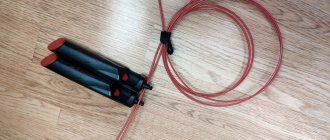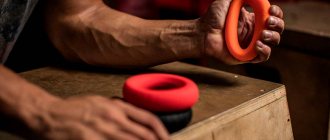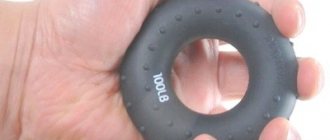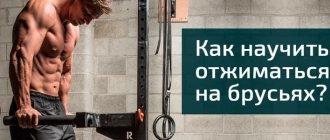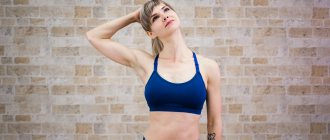Even if a person is in a stationary position, his muscles still do work, supporting the body and coordinating the body in space. In the human body there are a huge number of muscles, united in groups that work harmoniously, ensuring normal motor activity. Let's find out what static and dynamic muscles are, and how to use this knowledge for competent training. You will learn a lot of useful information on training and nutrition at the Multisport fitness club, where experienced specialists work who will help you achieve your desired goals in fitness and sports.
Static and dynamic exercises - what's the difference?
Static and dynamic exercises are the two main loads that trainers use in fitness rooms. When forming a complex, it is important to know how these two directions differ and what they influence.
Static exercises are aimed at fixing the body in a certain position for as long as possible. They are often found not only in regular fitness, but also in yoga, Pilates, and when exercising with fitball. During training, there is an increased supply of oxygen to the entire body, because blood flow accelerates and the blood quickly distributes oxygen throughout the body. In addition, statics has several more positive qualities:
- strengthens the immune system;
- develops strength and endurance;
- accelerates the removal of harmful substances from the body;
- has a positive effect on all internal organs.
Static exercises do not require much space. However, this load has one small drawback. It does not promote muscle growth in length. Therefore, they are often alternated with dynamic loads. Dynamics involves periodic back-and-forth movement of a body or its parts. Such exercises include: squats, push-ups, lunges, etc.
Strengths of dynamic load:
- successful muscle building;
- positive effect on joints and overall development of the motor system;
- metabolic processes are accelerated;
- excess calories are quickly burned, which leads to weight loss;
- the functioning of the heart and blood vessels improves.
As you can see, both directions have a certain effect on the body. It is important to properly distribute the load. If you decide to lose a few kilograms, then static exercises should be present in your workout, but occupy no more than one third of the entire complex. You should devote most of your time to dynamics. However, if you are still new to sports, then it is better to refrain from static exercises and after a while gradually introduce several exercises. This is due to the fact that the load requires a certain endurance and strength, which are so lacking in the initial stages.
Statodynamic training
Statodynamics is one of the most interesting sports techniques, which is gaining popularity among bodybuilders every year. Its main task is to hypertrophy oxidative muscle fibers to increase endurance and strength. The training was invented during the “golden era” of bodybuilding, and its classic scheme was proposed by Candidate of Biological Sciences, Professor Viktor Siluyanov.
The main criteria of the system include:
- short amplitude;
- mandatory refusal;
- availability of series;
- load time 30-45 sec;
- unregulated speed;
- rest for at least 10 minutes;
- only after strength training.
Siluyanov did not attach much importance to speed, while his follower Dmitry Yakovina emphasized doing the exercises slowly. This is due to the fact that during intense training, glycolytic muscle fibers are activated. To leave the GMV alone, activating the motor units of the GMV, you need to move at a slow pace. Yakovina modified statodynamic exercises, making some changes to the criteria. In his opinion, the rest time can be reduced to 5 minutes, beginners need low speed, more advanced bodybuilders work faster, there are no series. Modification of static dynamics is more adapted for powerlifting and bodybuilding.
Dynamics are beneficial for men and women. At the same time, weights are most often recommended for use by representatives of the stronger half of humanity. Which set of exercises to choose is up to everyone to decide for themselves. The main thing is that the desire for a beautiful, fit body does not negatively affect health, but, on the contrary, is in harmony with the right lifestyle and nutrition.
Static exercises for weight loss
Despite the fact that static exercises do not play a direct role in building muscle, they are still worth taking into account when creating a complex for weight loss. After all, fat breakdown occurs only if there is access to oxygen. And statics provide this factor. In addition, when burning fatty tissue, the body is filled with toxins, which also safely leave it thanks to certain exercises.
If you are just starting your acquaintance with statics, do not overload your body. Stay in each position for 15-20 seconds. To begin with, this will be enough and you will feel tension in the muscles being worked. After a certain time, when the exercises seem easy to you, begin to increase the duration of the tension to 2-3 minutes. Pay special attention to the technique of performing the exercise. Otherwise, you may harm your body. The most common static exercise that almost every instructor uses in their training is the plank. Several variations of its implementation are known. In each variant, almost all muscles are involved, both large and small, it’s just that in some cases some work more intensely, in others - others.
Another common exercise is squats. It can be performed both statically and dynamically. In the first case, you should sit down, while paying attention to the position of your body and legs, and stay at the lowest point for as long as possible.
Push-ups are also available for static loading. To do this, after lifting your body, lower it down and hold it on your bent arms and tips of your legs for 20-30 seconds.
We will describe how these exercises are performed below. Most often, the trainer gives a static load at the end of each dynamic exercise. For example, we performed squats 40 times dynamically, and stayed for a few seconds at the bottom point, this is already static.
Why do we need statics?
The question logically arises as to why isometric exercises are needed.
There is still heated debate about their benefits. And despite a number of obvious benefits, some effects are quite questionable.
Next, we present facts that no one doubts, without touching on controversial issues.
Pros and cons of exercise
Among the obvious benefits of isometric exercises:
- Availability
They can be performed anywhere and do not require expensive equipment or sports equipment.
- Ease of technical execution
Most can be mastered the first time. They do not require lengthy learning, as is the case with dynamic movements.
- Improved muscle tone
- Strengthening the muscles that stabilize the core, as well as the deep muscles that are responsible for the health of the spine
- Increased ligament and tendon strength
- The duration of such training is short and ranges from 10 minutes to half an hour (maximum)
Now let's move on to the disadvantages:
- May cause increased blood pressure
Such loads are not recommended for hypertensive patients (people with high blood pressure)
- Increases the load on the heart
Isometric tension compresses blood vessels (and the smallest capillaries). The heart has to work harder to push blood through them.
- Does not increase strength levels in dynamic exercises
This has long been known in strength sports. Indeed, in the 60-70s of the last century, isometric exercises were very popular. They were widely used in training athletes in various sports. Including weightlifting.
During that period, many studies were conducted to prove the undeniable advantage of static loads for increasing strength.
The results of the experiments turned out to be very contradictory, which caused heated debate among supporters and opponents of statics to increase strength indicators. Over time, the truth was finally established.
It turned out that isometric exercises actually help strengthen ligaments and increase strength, but the increase in strength occurs over a very short period.
More precisely, in the place where the muscle tension occurred.
In other words, the increase in static force does not carry over to dynamic motion.
For example, the plank with outstretched arms is essentially the starting position for push-ups. Logically, if the result in the plank increases, then the number of push-ups should also increase, which would indicate an increase in strength.
But this does not happen, since there is no linear relationship between increasing the time spent in the plank and increasing the number of push-ups on the floor.
Thanks to statics, muscles and ligaments are strengthened only in the upper phase of movement. And in the middle and lower sections of the amplitude, the strength does not increase.
In modern strength sports, the volume of isometric exercises in the training process is no more than 5-10%.
The remaining 90-95% comes from traditional dynamic strength movements.
- Does not promote fat burning
Static exercises for the legs, abs and buttocks, which many women love to do to lose weight, do not in any way affect fat burning in these areas.
They definitely increase the tone of the trained muscles and their density, but minimal energy consumption cannot significantly affect weight loss.
A set of static exercises
Here are a few static exercises that you can include in your complex.
- Classic plank. Lying on your stomach, lift your body and hold it by standing on your elbows and toes.
- Side plank. Now roll over onto your side. Raise your body and support it on one arm and leg. For beginners, you can focus on both legs, but in the future, aim to work with one leg. You can make the exercise more difficult by raising your other leg higher.
- Standing against a wall, lean against it and do a squat so that your thighs are parallel to the floor, without holding your breath, hold the position for several seconds.
Mechanical Features
Examples of static and dynamic muscle work:
- Load retention.
- Transportation of items.
Immobility includes all efforts that do not involve movement. This activity is accompanied by a clear fixation of the articular tissue. Physiologically, this is organized as follows: at one point in time, muscles that have the opposite purpose are contracted. As it was revealed in the course of specialized studies, static work provokes significantly greater fatigue than dynamic load.
Static abdominal exercises
You can work your abs using any static exercises; they all practically affect this area. But here are a few exercises that are aimed directly at the abdominal area:
- Lying on your back, press it tightly to the floor, move your arms behind your head, bend your legs at the knees, twist to one side and stay at the top point for as long as possible. Return to the starting position and repeat the exercise on the other side.
- Lying on your back, pressing it to the floor, move your hands behind your head. Raise your upper body and hold at the top point for 30-40 seconds.
- The starting position is the same, only now raise your legs at an angle of 35-40 degrees and hold them in this position.
- Sitting on the floor, move your body back a little, bend your legs at the knees and place them on the floor, stretch your arms forward. Rotate your body in one direction, hold in this position, and then in the other direction.
When performing all exercises, pay special attention to breathing. Do not hold it, but breathe smoothly and evenly.
Respiratory dynamics
Used to strengthen the abdomen, diaphragm, chest. It is best to start dynamic breathing exercises with 3-7 approaches, increasing their number over time and combining them with walks in the fresh air:
- Place your hands on your belt, inhale - bend back, exhale - bend forward, while the limbs lower, the shoulders come together.
- Hands on the hips, inhale - step forward with the left leg, head slightly thrown back, right foot on the toe, exhale - the leg returns to its place, head lowers slightly.
- Hands lowered along the body, take a deep breath and raise them above you, lean back a little. When exhaling, bend forward, touching your fingers to the floor, do not bend your knees.
The most optimal time for respiratory dynamics is the morning hours.
Dynamic physical exercises
This type of load is already familiar to you. Any exercise that requires movement is dynamic. These are squats, running, jumping, lunges - all this is dynamic, allowing you to burn excess fat and give your muscles a beautiful elongated look. When performing strength exercises, you can use additional weights. But this applies to a greater extent to the male population, who strive to increase muscle mass as much as possible. To burn subcutaneous fat, it is better for women to work with their own body weight, or use light dumbbells, no more than 1.5 kg.
The main thing is that during classes, try to perform the exercises correctly, tensing the right muscles and with full amplitude.
When performing regular exercise routines, do not forget about nutrition, which should match your lifestyle. Eliminate fast carbohydrates from it and the result will not take long to arrive.
When to expect the effect
When performing static loads, the first result will be obtained no earlier than after 90 days of constant training. During this period, the athlete must eat well, rest and do all exercises correctly.
If you regularly perform static training for 6 months, it is permissible to increase the duration of holding the body in a fixed position to 60 seconds.
Isometric exercises are considered a simple but effective method for developing muscle endurance, improving relief and strength. They act as a universal complex that can be performed at home without the use of sports equipment. Therefore, statics can be done without visiting the gym.
To exercise at home, you will need a fitness mat, sportswear, and a flat, hard floor. However, before performing static training, it is imperative to consult a therapist and perform a comprehensive examination of the body.
Statics is a universal way of training for absolutely everyone, regardless of age, goals and gender . Such sports are completely safe. At the same time, they will be very useful for the spine, systems and organs of the body.
In this regard, it is recommended to include these exercises in personal training in order to achieve the desired result faster and bring physical abilities to a higher level.
Theoretical basis
Muscle tissue is an integral component of the musculoskeletal human physiological system. Its distinctive feature is the ability to contract, and its main task is to provide the ability to move. Thanks to the presence of such fibers, a person can maintain a posture, move the body, speak, and breathe. Muscle tissue is formed by an elastic, elastic substance - a set of myocytes. The contraction is due to the influence of the nervous system, impulses directed by the brain. The intensity of the load provokes fatigue.
Thanks to muscles, you can move your body in space. With the help of muscle tissue, you can perform intended movements, from the simplest to the most energetic, typical for athletes or craftsmen working with very small objects. The healthy state of the three existing types of muscle tissue determines the possibility of mobility, activity, and the normal course of physiological processes. The nervous system controls work processes, connects the brain and muscle fibers, and organizes the process of reformatting chemical energy reserves into mechanical ones.
Why is this happening?
Such movements occur constantly, even if the eyes are open, and the person closely watches the movements of his hand. The fact is that they are usually characterized by a very small amplitude, so it is difficult to notice them visually. However, even with open eyes, fatigue quickly sets in, which leads to rough adjustment of the position, noticeable to the person himself and an outside observer.
The longer the static load persists, the stronger the body’s reaction:
- Limbs are shaking.
- The hand drops.
- Muscle tissue responds with pain.
This reaction of the body is due to metabolic processes. Products of biochemical interaction accumulate in the fibers, which leads to irritation of the receptors. After a fairly short period of time, the unpleasant sensations completely exhaust themselves.
You can continue the experiment described above. The same load is given to the person in the other hand, then the sequence of actions is repeated. In most cases, it is noted that the subject can withstand a static load for quite a long time without showing fatigue.

